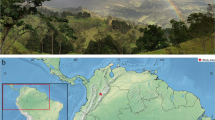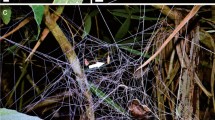Abstract
Diadromus pulchellus is a solitary ichneumonid parasitoid. Its only known host is the pupa of Acrolepiopsis assectella, a specialist herbivore of Allium species. D. pulchellus females parasitize A. assectella pupae within 48 h after the caterpillars spin their cocoon and begin to pupate. Having observed that the cocoon produced by the leek moth caterpillar stimulates parasitoid egg-laying and that caterpillar leaves a silk thread, we studied the hypothesis that silk thread might be involved in host-finding by the parasitoid. Behavioral tests showed that when D. pulchellus females encounter a host silk thread, they change directions, follow the thread, and quickly locate the host. These findings show that pupal parasitoids can use signals produced by their hosts at the developmental instar preceding the one that they parasitize.
Similar content being viewed by others
References
Allen, D. C., Knight, F. B., and Foltz, J. L. (1970). Invertebrate predators of the jack-pine budworm, Choristoneura pinus, in Michigan. Ann. Entomol. Soc. Am. 63: 59–64.
Auger, J., Lecomte, C., Paris, J., and Thibout, E. (1989). Identification of leek-moth and diamond back-moth frass volatiles that stimulate parasitoid, Diadromus pulchellus. J. Chem. Ecol. 15: 1391–1398.
Bekkaoui, A., and Thibout, E. (1993). Role of the cocoon of Acrolepiopsis assectella (Lep., Yponomeutoidea) in host recognition by the parasitoid Diadromus pulchellus (Hym., Ichneumonidae). Entomophaga 38: 101–113.
Bénédet, F., Bigot, Y., Renault, S., Pouzat, J., and Thibout, E. (1999). Polypeptides of Acrolepiopsis assectella cocoon (Lepidoptera Yponomeutoidea): an external host-acceptance kairomone for the parasitoid Diadromus pulchellus (Hymenoptera: Ichneumonidae). J. Insect Physiol. 45: 375–384.
Bénédet, F., Leroy, T., Gauthier, N., Thibaudeau, C., Thibout, E., and Renault, S. (2001). Gustatory sensilla sensitive to protein kairomones trigger host acceptance by an endoparasitoid. Proc. R. Soc. Lond. B. 269: 1879–1886.
Hislop, R. G., and Prokopy, R. J. (1981). Mite predator responses to prey and predator-emitted stimuli. J. Chem. Ecol. 7: 895–904.
Hoffmeister, T. S., Roitberg, B. D., and Lalonde, R. G. (2000). Catching Ariadne by her thread: how a parasitoid exploits the herbivore's marking trails to locate its host. Entomol. Exp. Appl. 95: 77–85.
Klomp, H. (1981). Parasitic wasps as sleuthounds: Response of an ichneumon wasp to the trail of its host. Neth. J. Zool. 31: 762–772.
Labeyrie, V. (1960). Contribution á l'étude de la dynamique des populations d'insectes. Influence stimulatrice de l'hote Acrolepia assectella Z. sur la multiplication d'un hyménoptére Ichneumonidae (Diadromus sp.). Entomophaga H.S. 1: 1–193
Lecomte, C., and Thibout, E. (1986). Analyse dans deux types d'olfactométres, du comportement de quete des femelles de Diadromus pulchellus en présence d'odeurs du phytophage hote et du végétal attaqué ou non. Entomophaga 31: 69–78.
Mac Manus, M. L., and Smith, H. R. (1972). Importance of the silk trails in the diel behavior of late instars of the gypsy moth. Environ. Entomol. 1: 793–795.
Nowbahari, B., and Thibout, E. (1990). The cocoon and humidity in the development of Acrolepiopsis assectella (Lep.) pupae: consequences in adults. Physiol. Entomol. 15: 363–368.
Quicke, D. L. J. (1997). Parasitic wasps. Chapman and Hall, London, 470pp.
Roessingh, P. (1989). Trail marking and following by larvae of the small ermine moth Yponomeuta cagnagellus. PhD Thesis, Agricultur. Univ., Wageningen, 119pp.
Rojas-Rousse, D. (1973). Etude du comportement sexuel chez Diadromus pulchellus Wesmael, parasite d' Acrolepia assectella. C. R. Acad. Sci. Paris 276: 1455–1458.
Sandlan, K. (1980). Host location by Coccygomimus turionellae (Hymenoptera: Ichneumonidae). Entomol. Exp. Appl. 27: 233–245.
Thibout, E. (1988). La spécificité de Diadromus pulchellus (Hyménoptére: Ichneumonidae) vis-á-vis de son hote Acrolepiopsis assectella, la teigne du poireau. Entomophaga 33: 439–452.
Thibout, E., and Nowbahari, B. (1987). La sélection du lieu de nymphose chez la teigne du poireau, Acrolepiopsis assectella (Lepidoptera): déterminisme exogéne et variations interpopulations. Ann. Soc. Entomol. Fr. 23: 183–192.
Thibout, E., Guillot, J. F., and Auger, J. (1993). Microorganisms are involved in the production of volatile kairomones affecting the host-seeking behaviour of Diadromus pulchellus, a parasitoid of Acrolepiopsis assectella. Physiol. Entomol. 18: 176–182.
Vinson, S. B. (1976). Host selection by insect parasitoids. Ann. Rev. Entomol. 21: 109–133.
Weseloh, R. M. (1977). Effects on behavior of Apanteles melanoscelus females caused by modifications in extraction of gypsy moth silk pheromone. J. Chem. Ecol. 3: 723–735.
Yeargan, K. V., and Braman, K. (1986). Life history of the parasite Diolcogaster facetosa (Weed) (Hymenoptera: Braconidae) and its behavioral adaptation to the defensive response of a lepidopteran host. Ann. Entomol. Soc. Am. 79: 1029–1033.
Yeargan, K. V., and Braman, K. (1989a). Life history of the hyperparasitoid Mesochorus discitergus (Hymenoptera: Ichneumonidae) and tactics used to overcome the defensive behavior of the green cloverworm (Lepidoptera: Noctuidae). Ann. Entomol. Soc. Am. 83: 393–398.
Yeargan, K. V., and Braman, K. (1989b). Comparative behavioral studies of indigenous hemipteran predators and hymenopteran parasites of the green cloverworm (Lepidoptera: Noctuidae). J. Kansas Entomol. Soc. 62: 156–163.
Author information
Authors and Affiliations
Corresponding author
Rights and permissions
About this article
Cite this article
Thibout, E. Role of Caterpillar Silk Thread in Location of Host Pupae by the Parasitoid Diadromus pulchellus. J Insect Behav 18, 817–826 (2005). https://doi.org/10.1007/s10905-005-8742-4
Revised:
Accepted:
Issue Date:
DOI: https://doi.org/10.1007/s10905-005-8742-4




